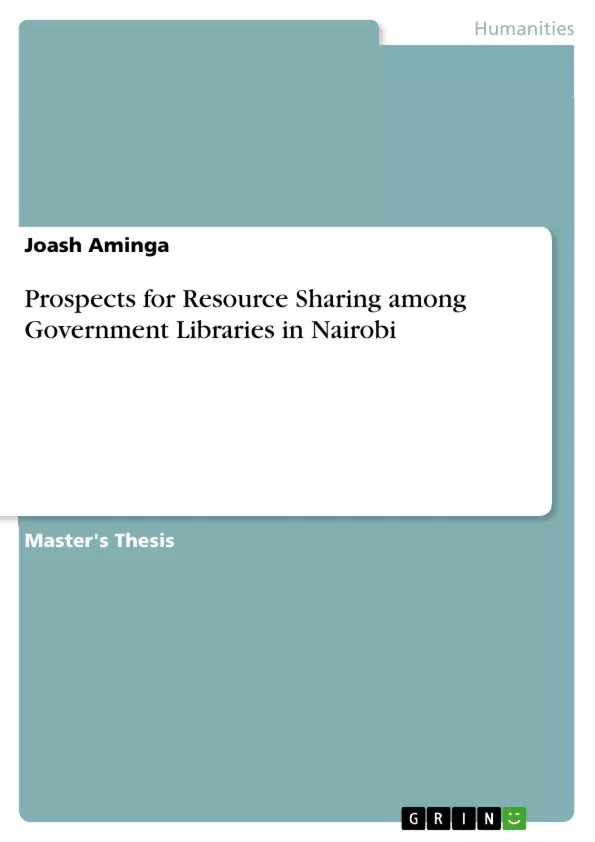Government libraries Kenya face many challenges, which include inadequate funding, inadequate space, increasing cost of library resources, and high proliferation of information literature, challenges in acquisition of modern equipment and facilities, increased demand for information by users, poor remuneration and lack of adequate qualified personnel. This calls for resource sharing as a means of overcoming some of these challenges. The aim of this study was to investigate the prospects of resource sharing in the provision of library services in Government ministries in Nairobi and ascertain the extent to which resource-sharing can assist to alleviate some of the challenges they are facing. The specific objectives of this study were to establish factors affecting the performance of Government libraries in Nairobi; examine Government policies within which these libraries operate and how these relate to the challenges of inadequate funding; establish the information resources and facilities available in Government libraries in Nairobi that can be shared among themselves; find out whether resource-sharing can assist to alleviate the challenges they are facing and propose recommendations to enhance resource-sharing among government libraries in Nairobi. This study is informed on the resource-sharing model as proposed by Sahoo (2009). The study used qualitative research method. Data was collected using face-to-face interviews, observations during the interviews as well as documentary evidence. Data was analyzed using qualitative and quantitative approaches. This study established that most government libraries in Nairobi do not share their resources effectively, they have inadequate information resources which are little used, limited accommodation space as well as lack of equipment and other facilities and, that no formalized library resource-sharing exists within government ministry libraries in Nairobi. The study recommends and shows how resource-sharing can be used to harness and/or improve the provision of information services in Government Ministry libraries in Nairobi; it also presents proposals necessary to establish a framework for their library resource-sharing.
Inhaltsverzeichnis (Table of Contents)
- Abstract
- Chapter One: Introduction
- 1.1 Background to the Study
- 1.2 Statement of the Problem
- 1.3 Purpose of the Study
- 1.4 Objectives of the Study
- 1.5 Research Questions
- 1.6 Significance of the Study
- 1.7 Scope of the Study
- 1.8 Limitations of the Study
- 1.9 Definition of Key Terms
- Chapter Two: Literature Review
- 2.1 The Concept of Resource Sharing
- 2.2 Importance of Resource Sharing
- 2.3 Benefits of Resource Sharing
- 2.4 Challenges to Resource Sharing
- 2.5 Models of Resource Sharing
- 2.6 Resource Sharing in Kenya
- 2.7 Summary of Literature Review
- Chapter Three: Research Methodology
- 3.1 Research Design
- 3.2 Target Population
- 3.3 Sample and Sampling Techniques
- 3.4 Data Collection Instruments
- 3.5 Data Collection Procedures
- 3.6 Data Analysis Procedures
- 3.7 Ethical Considerations
- Chapter Four: Presentation and Analysis of Data
- 4.1 Socio-economic Characteristics of the Respondents
- 4.2 Factors Affecting the Performance of Government Libraries in Nairobi
- 4.3 Government Policies Affecting the Libraries
- 4.4 Information Resources and Facilities Available for Sharing
- 4.5 Impact of Resource Sharing on Government Libraries
- Chapter Five: Discussion, Conclusion and Recommendations
- 5.1 Discussion of Findings
- 5.2 Summary of Findings
- 5.3 Conclusion
- 5.4 Recommendations
- References
- Appendices
Zielsetzung und Themenschwerpunkte (Objectives and Key Themes)
This study aimed to investigate the prospects for resource sharing in the provision of library services in Government ministries in Nairobi and ascertain the extent to which resource-sharing can assist to alleviate some of the problems they are facing. The specific objectives were to establish factors affecting the performance of Government libraries in Nairobi; examine Government policies within which these libraries operate and how these relate to the problems of inadequate funding; establish the information resources and facilities available in Government libraries in Nairobi that can be shared among themselves; find out whether resource-sharing can assist to alleviate the problems they are facing and propose recommendations to enhance resource-sharing among Government libraries. Key themes include:- Resource sharing in Government libraries in Nairobi
- Challenges facing Government libraries in Nairobi
- Factors affecting the performance of Government libraries
- Government policies impacting library services
- The potential of resource sharing to address these challenges
Zusammenfassung der Kapitel (Chapter Summaries)
Chapter One introduces the study, outlining the background, problem statement, purpose, objectives, research questions, significance, scope, limitations, and definition of key terms related to resource sharing in government libraries. Chapter Two delves into the literature review, exploring the concept of resource sharing, its importance and benefits, challenges to implementation, various models, and an overview of resource sharing practices in Kenya. Chapter Three details the research methodology employed in the study, outlining the research design, target population, sampling techniques, data collection instruments and procedures, data analysis procedures, and ethical considerations.
Schlüsselwörter (Keywords)
This study centers on the key concepts of resource sharing, government libraries, information resources, library services, and government policies. It examines challenges and opportunities related to the provision of library services within the context of resource constraints and the need for collaborative approaches. The study emphasizes the importance of resource sharing as a strategy for enhancing the effectiveness of government libraries in Nairobi, Kenya.- Citation du texte
- Joash Aminga (Auteur), 2012, Prospects for Resource Sharing among Government Libraries in Nairobi, Munich, GRIN Verlag, https://www.grin.com/document/287359



